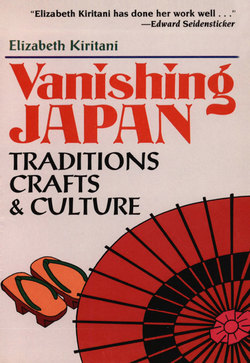Читать книгу Vanishing Japan - Elizabeth Kiritani - Страница 8
На сайте Литреса книга снята с продажи.
ОглавлениеPublicity Bands I
If you happen upon three or four people dressed outlandishly and dancing down the street banging on drums and tinny things, sparkling as they twirl and shout, chances are that you have run across the chindonya. Skipping and dancing, they disappear down an alley only to re-emerge from another, the leader clanging his metal gong while making official-sounding announcements, a saxophonist at the rear. No, it's not the Mad Hatter's tea party gone berserk, but the last of a long tradition of street advertising.
Chindon tradition dates back to the Meiji Era (1868-1912), when they were called tozaiya or hiromeya. In those times, jinta, or street musicians, who later accompanied silent films, performed the same type of street advertising. When the talkies started, these musicians, as well as a lot of itinerant actors and actresses, lost their jobs and many of them became chindonya. The name chindonya—which came into use during the early Showa Era (circa 1926)—comes from the sound of the leader's metal and leather drums which make a "chin" and "don" sound. Of course, in the old days there was less street noise and the chindonya were very loud and conspicuous.
The golden age of the chindon business was between 1946 and 1956, when work was plentiful and lucrative. Kinosuke Hanashima is the boss of a group that occasionally works in our neighborhood. His father and mother had been chindonya after the war and when his father died, he had to quit his job as a city worker to accompany his mother and help support their large family. His is a popular group: he has received four silver and at least ten bronze medals from the chindon association for their performances.
A group usually has seven members, of which up to four work at one time. This is so that at busy times the group can work two jobs by splitting up into one group of three and another of four. The one who heads the group as they proceed down the street is the hatamochi (or hataodori) who carries a flag and gives out leaflets. He or she is followed by the oyakata, the boss, who carries the chindon drums with their large paper umbrella propped up over them. The third in procession used to play the shamisen, but now is the doramuya, with one large drum, and the fourth is the gakkiya, or musician, who plays the saxophone, clarinet, or trumpet, in that order of popularity.
Costumes are determined by the oyakata and tend to be flamboyant. In Mr. Hanashima's group all (but the musician) wear chonmage (topknot) wigs, thick pancake makeup, and an eccentric combination of old Japanese clothing adorned with sequins. The musician is dressed like an old-time Westernized dandy: jacket, tie, and a rakish porkpie hat. The best groups are a mix of men and women—and most are made up of people whose roots are in the theater, music, or the arts.
Nowadays the advertising is mostly for pachinko parlors, store openings, and shopping area bargain sales. Sponsors are thinning out and Mr. Hanashima says that they work only about fifteen days a month. They make 15,000 yen apiece per day, so it costs 60,000 yen to engage them for a full day (10:30A.M.-5:00P.M.).
According to Mr. Hanashima, there are about forty groups in Japan, twenty of which are in or around Tokyo. He says it's a pleasant job in that most members are artists of some sort, they are doing what they want to do, and there is no retirement age. An energetic sixty-one, he looks forward to continuing for as long as he can. The bad side is that there are fewer and fewer sponsors. Times are tight, so if you're thinking of a surprise for your next party, you may be able to get a bargain. If you ask, though, remember to call them "chindon men." Mr. Hanashima says that this is the most flattering term for them—a nickname coined at the time when the "sandwich man" was the rage.
About 120 shops make up northern Tokyo's Kyoseikai shopping area, which had commissioned the group for one day in late December. They started off down the main street, greeting shop owners gaily, and then disappeared down the back alleys of the neighborhood where they would regale potential customers for the rest of the day. I asked one of the greengrocers whether he thought that the chindonya would increase his sales. A dubious look crossed his face. "Hmmm, I wonder . . ." was all he said. Toshie Tanaka, proprietress of a shop that sells tea, was more positive. She explained that they hire this group twice a year, right before New Year and Obon. "They wander through the neighborhood and create an atmosphere conducive to buying," she explained. "People hear them and think there is something special going on that they don't want to miss. Besides, we enjoy having them here. It brightens up our day too, you know."
